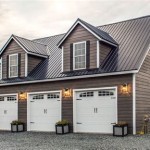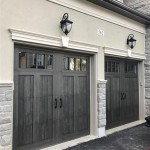How Wide Should A Garage Door Opening Be?
Determining the appropriate width for a garage door opening is a crucial aspect of garage construction and renovation. The width not only dictates the size of vehicles that can be accommodated but also significantly influences the overall usability and practicality of the garage space. A well-planned garage door opening ensures ease of access, protects vehicles from damage, and optimizes storage potential within the garage.
The standard dimensions for garage door openings are not arbitrary; they are based on common vehicle sizes and general space requirements. However, simply adhering to standard sizes may not always be the most suitable approach. Individual needs, specific vehicle types, and future plans for the garage should all be carefully considered when deciding on the optimal width. This article delves into the key factors that influence garage door opening width, providing a comprehensive guide to making informed decisions.
I. Standard Garage Door Widths
Standard garage door widths are designed to accommodate the majority of passenger vehicles and provide sufficient clearance for comfortable entry and exit. The most common widths are single-car and double-car sizes, each catering to different needs and space constraints.
For a single-car garage, the standard width is typically 8 feet (96 inches). This width provides adequate space for smaller vehicles such as compact cars and sedans. However, it may feel cramped for larger vehicles like SUVs or pickup trucks. While 8 feet is the minimum, many homeowners opt for a slightly wider opening, often around 9 feet (108 inches), to allow for easier maneuvering and to minimize the risk of accidental damage to the vehicle or garage door frame. An additional foot of width can make a significant difference in terms of comfort and convenience, particularly for drivers who are less experienced or who frequently need to park in tight spaces.
For a double-car garage, the standard width ranges from 16 feet (192 inches) to 18 feet (216 inches). A 16-foot wide door is generally suitable for two standard-sized cars parked side-by-side. However, similar to the single-car scenario, opting for a wider opening, such as 18 feet, provides considerably more room for each vehicle. This extra space simplifies parking, allows for easier access to the sides of the vehicles, and provides more flexibility for storage along the garage walls. In addition, an 18-foot wide door is often preferred if one or both vehicles are larger than average, such as a full-size truck or a minivan. The increased width also helps to prevent scratches and dents that can occur when maneuvering vehicles in a confined space.
It is important to note that these are just standard dimensions. Custom garage doors are available in a variety of widths, allowing homeowners to create a garage that perfectly suits their specific needs and preferences. While custom sizes may cost more than standard options, they can be a worthwhile investment if they provide significant improvements in functionality or convenience.
II. Factors Influencing Garage Door Width Selection
Selecting the appropriate garage door width involves careful consideration of several factors, including the size and number of vehicles to be housed, storage requirements, and architectural constraints. A thorough assessment of these factors will help to determine the optimal width for maximizing the usability and value of the garage space.
The size of the vehicles is a primary consideration. As mentioned previously, larger vehicles such as SUVs, trucks, and vans require more space than smaller cars. If the garage will be used to store such vehicles, a wider door opening is essential. Measure the width of the widest vehicle at its widest point, including side mirrors if necessary. Then, add at least 12 inches on each side to allow for comfortable maneuvering. This will provide a rough estimate of the minimum required garage door width. Failing to account for the size of these larger vehicles can lead to frustration and potential damage to the vehicles or garage door frame.
Beyond vehicle size, consider the number of vehicles that will be parked in the garage simultaneously. While a single-car garage is sufficient for one vehicle, a double-car garage is typically needed for two vehicles. However, the standard widths for double-car garages may not be adequate if the vehicles are particularly large or if additional space is needed for storage or access. In such cases, a wider custom door may be necessary to ensure that both vehicles can be parked comfortably and that there is sufficient room to move around them.
Storage needs also play a vital role in determining garage door width. Many homeowners use their garages not only for parking vehicles but also for storing tools, equipment, and other household items. If the garage will be used for storage, it is important to leave sufficient space along the walls to accommodate storage shelves, cabinets, or workbenches. This means that the garage door opening should be wide enough to allow vehicles to be parked without obstructing access to the storage areas. The depth of storage shelves and the expected frequency of access should factor into this calculation. Consider future storage needs as well. It's often more cost-effective to plan for these needs up front, rather than incurring remodeling costs later.
Finally, architectural constraints may limit the available width for the garage door opening. The overall size and layout of the property, the location of the garage relative to other structures, and any local building codes or regulations may restrict the dimensions of the garage. It is important to consult with a qualified architect or contractor to ensure that the chosen garage door width complies with all applicable requirements and is structurally sound.
III. Planning for the Future
When determining the appropriate garage door width, it is essential to consider not only current needs but also potential future requirements. Changes in vehicle ownership, family size, or lifestyle can all impact the way the garage is used and the amount of space that is needed. Planning for these potential changes can help to avoid the need for costly renovations or replacements in the future.
One of the most common future considerations is the potential for acquiring larger vehicles. As families grow or recreational interests evolve, homeowners may find themselves needing to accommodate larger vehicles such as SUVs, trucks, boats, or RVs. If there is a possibility of acquiring such vehicles in the future, it is wise to choose a garage door width that can accommodate them. This may involve opting for a custom door that is wider or taller than standard sizes. Even if a larger vehicle isn't immediately planned, the added space offers flexibility and convenience that can enhance the garage's long-term value.
Changes in family size can also influence garage door width requirements. As children grow older and begin driving, the need for additional parking space may increase. If the garage is currently designed to accommodate only one or two vehicles, it may be necessary to expand the garage or replace the existing door with a wider one to accommodate additional vehicles. Alternatively, the garage may become a hub for family activities, like hobbies or sports gear storage. This can generate a need for wider access, allowing more people to comfortably maneuver and access the space.
Finally, changes in lifestyle can also impact garage door width requirements. For example, if a homeowner plans to start a home-based business that involves storing or working on large equipment or materials, a wider garage door may be necessary to facilitate the movement of these items. Similarly, if a homeowner plans to convert the garage into a workshop or hobby space, a wider door may be desirable to allow for better access and ventilation. Considering these potential lifestyle changes can help to ensure that the garage remains functional and adaptable for years to come. Furthermore, making decisions now can help avoid future inconveniences and costly remodeling.

What Are Standard Garage Door Sizes Single Double Jb Doors

Understanding Standard Garage Door Sizes Premium Living Victoria

What S The Standard Garage Door Height A Sizing Guide

Garage Door Width

Overhead Door Opening Dimensions Hansen Buildings

How To Measure A Garage Door Height Guide
.jpg?strip=all)
Garage Door Sizes And Measurements Up Over Sectional Roller Shutter Side Hinged Garages

Garage Door Width

How To Frame For A Garage Door Doors Done Right And Openers

Standard Garage Door Sizes Single Double Roller Doors Sectional
Related Posts








